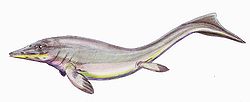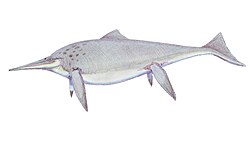| Jabalisaurus Temporal range: | |
|---|---|
| Scientific classification | |
| Domain: | Eukaryota |
| Kingdom: | Animalia |
| Phylum: | Chordata |
| Class: | Reptilia |
| Order: | † Ichthyosauria |
| Family: | † Ophthalmosauridae |
| Genus: | † Jabalisaurus Barrientos-Lara & Alvarado-Ortega, 2021 |
| Species: | †J. meztli |
| Binomial name | |
| †Jabalisaurus meztli Barrientos-Lara & Alvarado-Ortega, 2021 | |
Jabalisaurus is an ophthalmosaurid ichthyosaur from the Late Jurassic La Caja Formation of Mexico. It contains a single species, Jabalisaurus meztli. [1]
It was initially identified as a specimen of a Ophthalmosaurus cf. icenus. [2]







